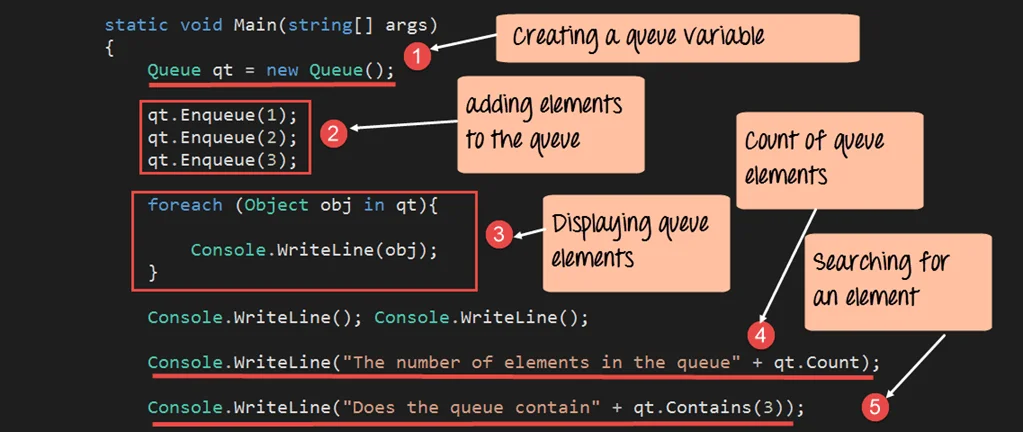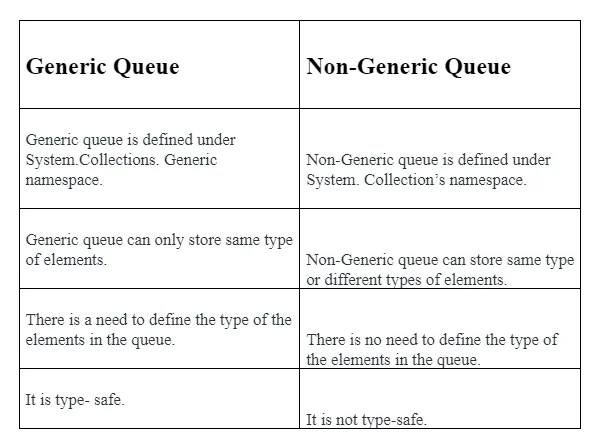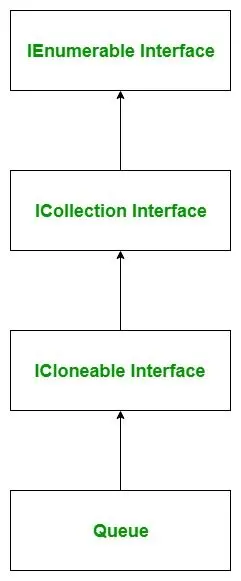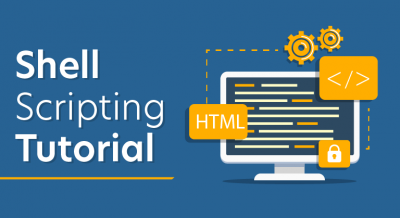
- Introduction to Queue in C#
- About the Queue Collection in C#
- Is a Queue an assortment in C#?
- How does Queue function in C#?
- Constructors of Queue function in C#
- Significant Points
- How to make the Queue?
- How about we perceive how to make a Queue utilizing Queue () constructor
- How to eliminate components from the Queue?
- How to get the highest component of the line?
- How to look at the accessibility of components in the line?
- Generic Queue Vs Non-Generic Queue
- Methods of Queue in C#
- Charateristics of Queue in C#
- Operation of Queue in C#
- Properties
- The advantages and disadvantages of queue
- Disadvantages
- Line capacities in C# strategy
- Pre-Requisities
- Conclusion
- A line is an assortment of items it addresses as FIFO (First-In-First-Out) request the component which is added first will come out first, in C# Queue assortment class present in the namespace System. Collection. Line stores the component in FIFO request in which we can recover in an earliest in, earliest out way of getting to components. A line is only inverse to Stack Collection, where Stack is LIFO (Last-In-First-Out).
- The assortment of Queue permits various invalid and copy esteems. The line utilizes two techniques called Enqueue () and Dequeue () which are utilized for adding and recovering qualities separately.
- In software engineering, a line is an assortment of substances that are kept up within a grouping and can be changed by the expansion of elements toward one side of the succession and the expulsion of elements from the opposite finish of the arrangement. By show, the finish of the arrangement at which components are added is known as the back, tail, or back of the line, and the end at which components are eliminated is known as the head or front of the line, comparably to the words utilized when individuals line up to sit tight for labor and products.
- The activity of adding a component to the back of the line is known as en queue, and the activity of eliminating a component from the front is known as de queue. Different activities may likewise be permitted, frequently including a look or front activity that profits the worth of the following component to be dequeued without dequeuing it.
- The tasks of a line make it an earliest in, earliest out (FIFO) information structure. In a FIFO information structure, the main component added to the line will be the first to be taken out. This is comparable to the prerequisite that once another component is added, all components that were added before must be eliminated before the new component can be taken out.
- A line is an illustration of straight information construction, or all the more uniquely a consecutive assortment. Lines are normal in PC programs, where they are carried out as information structures combined with access schedules, as a theoretical information structure, or in object-situated dialects as classes. Normal executions are roundabout supports and connected records.
- Lines offer types of assistance in software engineering, transport, and tasks research where different elements like information, items, people, or occasions are put away and held to be handled later. In these unique situations, the line fills the role of a cushion. One more use of lines is in the execution of broadness first hunt.
- Line present as FIFO (First-In-First-Out) it’s an assortment of articles, this interaction is utilized when we want to access in earliest in, earliest out access of things. The line is non-nonexclusive it utilizes the kind of assortment which is characterized in the System. Collection’s namespace. By and large, a line is helpful when we utilize the data in the manner which we put away in the line assortment.
- The Queue carries out through the connection points called IEnumerable, ICloneable, ICollection. For the reference types, it acknowledges the invalid legitimate qualities. Inline assortment for adding a thing, we utilizing the Enqueue strategy and for erasing a thing we utilizing the Dequeue technique while adding a thing to line the all out limit is consequently increment for required interior memory.
- The Queue class carries out the IEnumerable, ICollection, and ICloneable points of interaction.
- At the point when you add a thing in the rundown, it is called en queue.
- At the point when you eliminate a thing, it is called dequeue.
- Line acknowledges invalid as a substantial incentive for reference types.
- As components are added to a Queue, the limit is naturally expanded as expected by redistributing the inside exhibit.
- In Queue, you are permitted to store copy components.
- The limit of a Queue is the number of components the Queue can hold.
- utilizing System.Collections;
- Line queue name = new Q
- C# program to show how to eliminate components from line
- utilizing System;
- utilizing System. Collections;
- public class GFG {
- static public void Main()
- {
- // Make a line
- // Utilizing Queue class
- Line my_queue = new Queue();
- // Adding components in Queue
- // Utilizing Enqueue() strategy
- my_queue.Enqueue(“GFG”);
- my_queue.Enqueue(1);
- my_queue.Enqueue(100);
- my_queue.Enqueue(2.4);
- my_queue.Enqueue(“Geeks123”);
- Console.WriteLine(“Total components present in my_queue: {0}”,
- my_queue.Count);
- my_queue.Dequeue();
- // After Dequeue strategy
- Console.WriteLine(“Total components present in my_queue: {0}”,
- my_queue.Count);
- // Eliminate every one of the components from the line
- my_queue.Clear();
- // After Clear technique
- Console.WriteLine(“Total components present in my_queue: {0}”,
- my_queue.Count);
- }
- }
- Absolute components present in my_queue: 5
- Absolute components present in my_queue: 4
- Absolute components present in my_queue: 0”
- Queue.Enqueue Method
- Queue.Dequeue() Method
- Queue.Contain() Method
- Queue.Clear() Method
- Queue.Peek Method
- Queue.ToArray() Method
- Queue<'T> is FIFO (First In First Out) assortment.
- It goes under System.Collection.Generic namespace.
- Queue<'T> can contain components of the predefined type. It gives gather time type checking and doesn’t perform boxing-unpacking because it is nonexclusive.
- Components can be added utilizing the Enqueue() technique. Can’t utilize assortment initializer sentence structure.
- Components can be recovered utilizing the Dequeue() and the Peek() strategies. It doesn’t uphold an indexer.
- Enqueue adds a component to the furthest limit of the Queue.
- Dequeue eliminates the most seasoned component from the beginning of the Queue.
- Look returns the most seasoned component that is toward the beginning of the Queue however doesn’t eliminate it from the Queue.
- The limit of a Queue is the number of components the Queue can hold.
- As components are added to a Queue, the limit is consequently expanded as expected by redistributing the inward cluster.
- Line acknowledges invalid as a substantial incentive for reference types and permits copy components.
- Simple to begin
- Less Hardware Requirement
- Cross-Platform
- “An information structure is a technique for getting sorted out data. These constructions incorporate documents, records, clusters, trees, records, and tables. Lines are connected with requested records. With the line, the new bits of information are put at the back of the information structure, and the cancellations are set at the front.
- The main piece of information that went into the information structure is the primary piece eliminated from the design. With lines, the information doesn’t stay in the information structure however long with stacks. Lines can measure up to lines at the store, where the main individual in line is the principal individual to get help.”
- Lines enjoy the benefits of having the option to deal with different information types and they are both adaptable and adaptability and quick. Besides, lines can be of possibly endless length contrasted and the utilization of fixed-length clusters.
- Not adaptable
- Absence of scalability
- Incapable to Copy and Paste
- To remember another component for the line, different components should be erased.
- Where the line stays full however we can not embed another component because the rear of the line (right-hand side) stays as it was previously. This is the significant constraint of a traditional line, for example regardless of whether there is space accessible at the front of the line we can not utilize it.
Introduction to Queue in C#:
About the Queue Collection in C#:
Is a Queue an assortment in C#?
The line is a unique kind of assortment that stores the components in FIFO style (First In First Out), precisely inverse of the Stack<'T> assortment. It contains the components in the request they were added. C# incorporates nonexclusive Queue<'T> and non-conventional Queue assortment.
C# Queue with Examples:
A Queue is utilized to address a first-in, first-out (FIFO) assortment of articles. It is utilized when you want earliest in, earliest out access of things. It is the non-nonexclusive sort of assortment which is characterized in the System. Collections namespace. It is utilized to make a unique assortment that develops, as indicated by the need of your program. In Queue, you can store components of a similar kind and the various sorts.
For the most part, a line is useful when you access that data similarly in which they put away in the assortment and it is the impermanent capacity to store information.
How does Queue function in C#?
Constructors of Queue function in C#:
In Queue class it comprises constructors that are utilized to make a line.
Line ():
The constructor Queue () is utilized for making the occasion of line class, it helps in the utilization of default development factor.
Queue (ICollection):
This constructor is utilized for making an occasion of the line and it contains the things duplicated from the predefined assortment and has a similar limit as the number of things replicated. It likewise utilizes the default starting development factor.
Queue (Int32):
This constructor is utilized to make a Queue class occasion that is vacant and has a beginning limit determined, and utilizes the default development factor.
Queue (Int32, Single):
This constructor is utilized to make a Queue class case that is unfilled and has an introductory limit determined, and utilizes the default development factor.

Significant Points:
How to make the Queue?
Line class has four constructors which are utilized to make the line which is as per the following:
Line (): This constructor is utilized to make an occasion of Queue class which is vacant and has the default starting limit, and uses the default development factor.
Queue (ICollection): This constructor is utilized to make a case of Queue class which contains components duplicated from the predetermined assortment, has a similar starting limit as the number of components replicated, and utilizes the default development factor.
Queue (Int32): This constructor is utilized to make an occurrence of Queue class which is unfilled and has a determined introductory limit, and uses the default development factor.
Queue (Int32, Single): This constructor is utilized to make an example of Queue class which is unfilled and has indicated introductory limit, and uses the predefined development factor.
How about we perceive how to make a Queue utilizing Queue () constructor:
Stage 1: Include System.Collections namespace in your program with the assistance of utilizing catchphrases.
Stage 2: Create a line utilizing Queue class as displayed underneath:
Stage 3: If you need to add components in your line then, at that point, use Enqueue () technique to add components in your line. As displayed in the underneath model.
How to eliminate components from the Queue?
In Queue, you are permitted to eliminate components from the line. The Queue class gives two distinct strategies to eliminate components and the techniques are:
Clear: This strategy is utilized to eliminate the articles from the line.
Dequeue: This strategy eliminates the starting component of the line.
Output:
How to get the highest component of the line?
In Queue, you can without much of a stretch observe the highest component of the line by utilizing the accompanying techniques given by the Queue class:
Look: This strategy returns the item toward the start of the Queue without eliminating it.
Dequeue: This technique returns the item toward the start of the Queue with change implies this strategy eliminates the highest component of the line.
How to look at the accessibility of components in the line?
In Queue, you can check whether or not the given component is available utilizing Contain() technique. Or then again as such, to look through a component in the given line use Contains() strategy.
Generic Queue Vs Non-Generic Queue:

Methods of Queue in C#:
Charateristics of Queue in C#:
Operation of Queue in C#:
Line addresses an earliest in, earliest out the assortment of the article. It is utilized when you want an earliest in, earliest out access of things. Whenever you add a thing in the rundown, it is called enqueue, and when you eliminate a thing, it is called de queue.
Queue<'T>.Enqueue(T) Method is utilized to add an item to the furthest limit of the Queue<'T>.
Properties:
The advantages and disadvantages of queue:
The benefits of lines are that the various information can be dealt with, and they are quick and adaptable.
Disadvantages:
So to defeat the issue above, we can utilize around the line. Concerning Circular Queue – Data Structures, this can be characterized as a “direct information structure in which the activities are performed given FIFO (First In First Out) rule and the last position is associated back to the principal position to make a circle.” We can address this round line as:
Assuming a line is viewed as a roundabout, when a de-line activity happens, re-guiding the top of the line toward the following component is a straightforward task. This likewise keeps away from broad re-buffering when every one of the components would some way or another move one to one side after a de-line happens.
Line capacities in C# strategy:
How about we see the accompanying capacities list which is normally utilized techniques for the Queue class −
Enqueue ():
Enqueue technique is involved while adding a component in Queue, it is a non-nonexclusive assortment so we can add a component of any datatype in this strategy. The mark utilized for this strategy is void Enqueue (object obj)
Dequeue ():
Dequeue strategy is for access line which is utilized to recover the highest component in the line. By the FIFO approach Dequeue is used to eliminate and its resultant one which returns the main component in the line assortment, the Dequeue () is called just when the complete count of the line is more prominent all of the time than zero in any case it tosses a special case. The mark utilized for this strategy is object Dequeue ()
Look ():
This technique will return generally the primary component from the line assortment without eliminating it from the line. It tosses a special case on the off chance that the unfilled line assortment is called. The mark utilized for this technique is object Peek ().
Clear ():
This strategy is utilized to eliminate objects from the line assortment. The mark utilized for this strategy is void Clear ().
Contains ():
This technique is utilized to check whether a component exists in the assortment of Queue. The mark utilized for this strategy is bool Contains (object obj).
Clone ():
Clone () strategy is utilized for making a shallow duplicate of line assortment.
Equals (Object):
This technique is utilized to check whether the specific article is equivalent to the current item.
Synchronized (Queue):
This technique returns another line that encases the first line.
Trimetozine ():
This technique is utilized to set the ability to which the genuine number of things in the line assortment.

Pre-Requisities:
This class executes a conventional line as a round cluster. Objects put away in a Queue<'T> is embedded toward one side and eliminated from the other. Lines and stacks are helpful when you want impermanent capacity for data; that is, the point at which you should dispose of a component after recovering its worth. Use Queue<'T> assuming you want to get to the data in the very request that it is put away in the assortment. Use Stack<'T> assuming you want to get to the data in invert request. Use ConcurrentQueue<'T> or ConcurrentStack<'T> assuming you want to get to the assortment from different strings simultaneously.
Conclusion:
In this article, we came to know the Queue () utilization in C#, it depends on the FIFO idea, for adding and erasing the line we utilize the Enqueue () and Dequeue () strategies individually.






